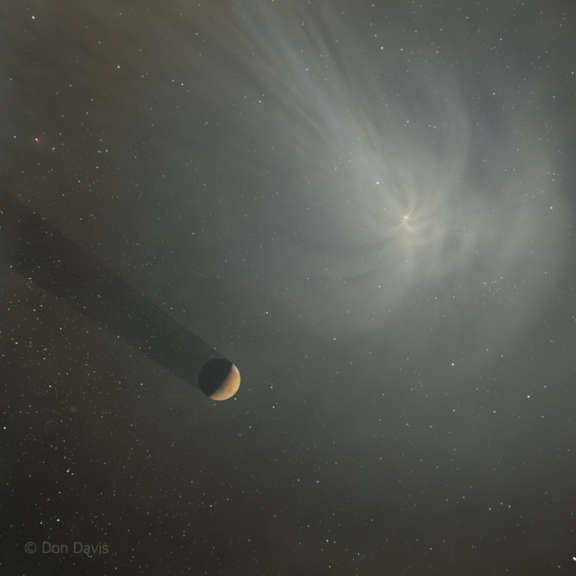Emily Lakdawalla • Oct 17, 2014
Watching Siding Spring's encounter with Mars
The nucleus of comet Siding Spring passes close by Mars on Sunday, October 19, at 18:27 UTC. Mars passes through the densest part of the comet's tail about 100 minutes later. All five orbiters at Mars will be in constant contact with the Madrid and then Goldstone Deep Space Network facilities, just to make sure they're okay. One-way light time to Mars right now is just under 14 minutes. There are tons and tons of scientific observations planned by Mars orbiters, Mars rovers, and Earth-based observatories. In fact, most of the facilities that are planning to observe Siding Spring have already begun their work, and will continue observation for days after the encounter.

What to expect on Sunday? It's not like a Mars landing; there won't be a single moment when a bunch of serious-looking engineers suddenly erupt into cheers. Instead, there'll be many smaller, non-televised moments as instrument teams receive their data from far-flung spacecraft and telescopes, spread out over the next several days. For the most part, the images of the comet won't be instant classics; many will show only a single pixel, or a faint smudge. Some of the data won't even arrive on Earth until the middle of next week. Most will require careful calibration and processing before they can be released, because they're being taken by spacecraft being used in unusual ways. None of them will look like the artist's visualization above. I will watch for images and post them over the coming week.
But the flyby is a big deal and I know people will want to follow it in real time, if only to be space fans enjoying a big space event at the same space time, so here are some suggestions for how you can do that. I will be checking in via Twitter over the weekend, and so will Bruce Betts; you can just follow us or try searching on the hashtags #MarsComet or #SidingSpring. And here are links to some webcasts and useful resources. I'll add more as I find them; please feel free to add links in the comments, too.
Webcasts:
- Amateur astronomer Peter Lake, will broadcast from the iTelescope.net Observatory (Q62) at Siding Spring, though closest approach won't be visible from Australia (broadcast starts at 03:00 PT / 10:00 UT)
- Astronomer Gianluca Masi will broadcast from the virtualtelescope.eu observatory (broadcast starts at 08:45 PT / 16:45 UT)
- ESA Livestream with lots of experts (broadcast starts at 10:50 PT / 17:50 UT)
- Slooh has two broadcasts, one during closest approach (starts 11:15 PT / 18:15 UT) and one afterward (17:30 PT / 01:30 UT). The later one will feature Bob Berman and David Grinspoon answering questions from Twitter using the #SloohComet hashtag.
Background information:
- Siding Spring coverage at the Planetary Society Blog
- Coordinated Investigations of Comets website; also see CIOC leader Karl Battams' Twitter
- NASA's and ESA's Siding Spring websites
- A thorough backgrounder with a cool animation from University of Arizona
- How to observe it yourself, from Universe Today
- Pro-Am Collaborative Astronomy Facebook, Twitter, and Flickr pages will likely have nice amateur images
- Deep Space Network Now will show you which dishes are talking to spacecraft, when
Here's a nice graphic of the separation between the comet and Mars at closest approach, by Adolf Schaller:

Finally, I need to share a sad blog post I read today: the dark skies above Siding Spring observatory, where this and other comets were discovered, are under threat by development of coal seam gas mining in its vicinity:
As comet Siding Spring (C/2013 A1) passes Mars, comet discoverers with current or previous involvement with Siding Spring Observatory are concerned about the future of the Observatory. The viability of Siding Spring Observatory in Coonabarabran, NSW, Australia, is threatened due to the intention of Santos to develop industrial scale CSG (Coal Seam Gas) mining in its vicinity. The effect of light pollution from gas flaring and security and operational lighting, in addition to airborne dust and industrial contaminants, could threaten the dark sky status of Australia's largest optical observatory complex, the home to many Australian and International telescopes. Dust and pollutants in the atmosphere increase reflected light and can have a detrimental effect on telescope optics.
Let’s Go Beyond The Horizon
Every success in space exploration is the result of the community of space enthusiasts, like you, who believe it is important. You can help usher in the next great era of space exploration with your gift today.
Donate Today

 Explore Worlds
Explore Worlds Find Life
Find Life Defend Earth
Defend Earth

